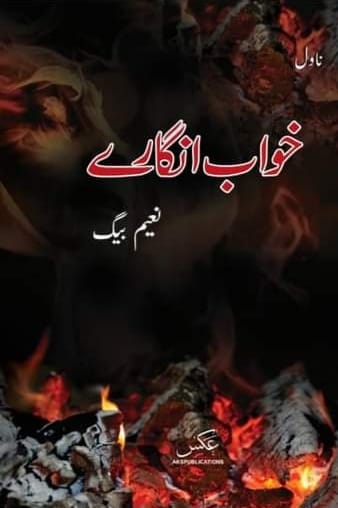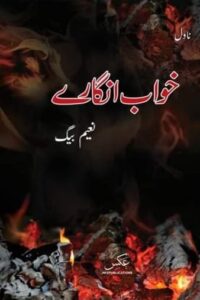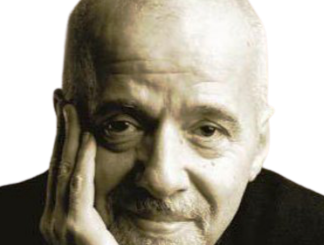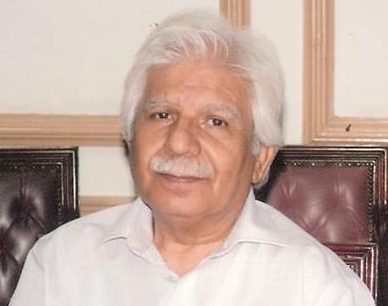
Khawb Angaray…An Intriguing Enigma
by, Prof. Sultan Mahmood Niazi & Dr. Ayesha Maqsood
We are willing to concede that the phrase ‘a mountain hidden behind a mole’ stands good in the case of Naeem Baig’s latest book. The thin sliver of a novelette titled ’Khawb Angaray’ is really baffling and challenging for those who dare to fathom the depths of its contents. It compels the readers to delve deep in order to gauge its propensity, from whatever angle they may intend to judge its range.
Generally, a piece of abstract art spell-binds the beholders with its ambiguity and fills them with wonder. Its ambiguity motivates them to solve the enigma and comprehend the essence and, once the task is accomplished, the feelings of wonder grasp our sensibilities and take us to the realms of ecstasy.
Just at the start of the book, “Khawb Angaray’, we are faced with the challenge of comprehending the complex chronological order of the contents.
The introductory chapter bears the date February ,2014, while the next chapter carries the tag of July, 2010 and narrates the horrific suicide attack, resulting in numerous casualties caused by terrorist explosions in the vicinity of ‘Data Darbar’ in Lahore, when more than fifty people lost their lives. When we reach the concluding chapter after going through the labyrinth of zigzag chronological order, we are baffled to see that the last chapter tagged as ‘Conclusion’ bears the stamp of January, 2013, i.e. almost one year before that of the introductory chapter.
Such a strategy of reshuffling of the chronological order was applied by Joseph Conrad in his novels, particularly, in Lord Jim, where the consequences of delinquency precede the narration of the description of the nature of the delinquency. Such intentional shuffling of the chronological order compels the reader to be mentally awake all through the act of perusing the contents. Naeem Baig has revived the tradition by maneuvering the chronological order of the events.
Subject-wise, the novelette, goes on revealing the immensity of its scope by first referring to the sense of insecurity and political and terrorist occurrences periodically reported in the local press and clandestinely dissipated by the vested groups with the objective of maligning the constitutional institutions of the state; then it presents the analogous situation prevailing in Catalonia and stretches it further to cover the global movements.
It is not just a novel, it can be considered to be a documentation of the ideological foundations and established ideals of Pakistan. Utilizing the basic framework of the story, the author has presented a complete overview of the various systems, like the systems of British Democracy, Basic Democracy, Theocracy, Socialism, Patriotism, Freedom of Expression and Transparency Theory having been experimented in the state.
The ultimate subject of the book doesn’t remain confined to the vast desolation of merely one piece of land unfortunately or intentionally kept deprived of the effects of development, it assumes the dimensions of a complete dissertation on the campaigns for self-rule and prosperity for all, when the global perspective of struggle for rights of down-trodden people all over the world comes under discussion.
Naeem Baig, being a seasoned novelist, has skillfully applied the metaphors of ‘darkness’ and ‘light’ with the object of drawing the readers’ attention to the basic causes of backwardness in Balochistan. ‘Darkness with particular reference to Balochistan, doesn’t stand for ignorance alone; it also takes elements of injustice and greed in its ambit. Sardars and Waderas are aware that their subjects have been suffering from poverty and squalor but they are bent upon keeping firm hold on the ordinary people.
Balochs apprehend that their ethnic identity is at stake, while the only guarantee to safeguard their identity lies hidden in the acquisition of quality education and building their capabilities to the extent that they show the courage to enter into competition with confidence and prove their merit. Shehnaz Baloch, and after her Saba and Saroop Baloch, dreamt of such an eventual triumph for the province, but the disciples of darkness thwarted their ambitions and did not let them turn their dreams into reality.
Naeem Baig has structured the story of ‘Khwab Angaray ‘ on the foundations of education and rational thinking. Rational thinking is the expression of self and patriotism. He, himself, is a staunch patriot and lover of peace.
He finds his country in a state of war and starts a peaceful campaign. He finds his country in a state where wealth is not earned but robbed. There are persons like Shehnaz Baloch, who stand for peace and awareness, but they are vanquished as a reaction to the transparency theory. Khwab Angaray is a reverberation of the mournful dirge of a state where people are put to death as a reaction to some ideology or narrative.
People who dare to spread the message of peace are eliminated. People who strive to open the avenues of education and awareness are exterminated. Naeem Baig’s novel is a protest. Barren wilderness of Balochistan can only be turned into idyllic land of promise through education and awareness, alone. Naeem Baig asserts that Balochistan has been made desolate. It doesn’t mean that Balochistan lacks people whose hearts throb with the love of education and peace. The author has presented a gallery of gallant characters like Shehnaz Baloch, Mir Khan Jamaldini, Saba Baloch and Saroop Baloch.
The reactionary movement sprouted in the province in retaliation to ill-planned theocratic and autocratic governance. The symbol of ‘darkness’ indicates the peculiar mental attitude of the tribal chiefs and waderas.
The author doesn’t name or blame any particular chieftain. His intention is to portray the attitude which stood in the way of progress for all. It is natural phenomenon that sun rises late and sets early in the valleys surrounded by hills. The period of darkness, there, is longer as compared to that in the plains. The dark valleys are witness to the surreptitious burial of corpses and their exhumation and reporting in the daytime.
“میں نے گردن اٹھا کر دیکھا۔ کچھ لوگ دو گاڑیوں میں قبرستان کے اندر آئے اور قبروں سے دور ہی انھوں نے اپنی گاڑیاں روک لیں۔ ان میں سے ایک شخص جو اپنی سیٹ پر بیٹھا تھا۔ جمائی لیتے ہوئے اترا اس کے ساتھ ہی اس کا دوسرا ساتھی کار کی دوسری طرف سے آن ملا۔ دونوں نے چاروں طرف نظر دوڑائی میرا خیال ہے کہ انھیں کچھ سجھائی نہیں دے رہا ہو گا، کیوں کہ یہ گھپ اندھیری اماوس کی رات تھی” (ابتدائیہ صفحہ ۷)
If we focus on the terms like ‘yawning’, ’boggled minds’, ‘pitch dark nights’ and ‘incidents of terrorism’, it transpires that all such terms refer to ignorance and intellectual backwardness.
“سروپ کی یہ خوش قسمتی تھی کہ شہناز بلوچ نے ابتدائی تعلیم کے بعد سروپ کو برطانیہ بھجوایا تھا۔ اس کے دو فائدے تو باکل عیاں تھے پہلا تعلیمی کہ اس نے کنگز کالج، لندن سے انٹر نیشنل ریلیشنز میں ماسٹر کیا۔ بعد میں تاریخِ عالم اور سیاسیات میں ثقافتی رُجحانات پر یونی ورسٹی آف بارسلونا میں ایم فل کرنے کی ٹھانی۔ چوبیس برس کی عمر میں مغربی تعلیم نے اس کے ذہن کے دریچوں کو یک سر کھول دیا۔ یہی وجہ تھی کہ اس کے اندر عام جاگیر دارانہ اور سرمایہ دارانہ جراثیم پیدا نہ ہو سکے جو پاکستانی اور بالخصوص بلاچستان کے ماحول کا خاصا تھے۔” (کوئٹہ سے مغرب میں، ص:۲۰)
‘Khawb Angaray’ depicts the state of emotional and intellectual compatibility between Saroop Baloch and Rika so effectively that it could easily lead to finding some workable solution to the Balochistan Issue through a comparative analysis of the self-rule movement in Balochistan and the Movement of Catalonian Separatists’ in Spain.
”اُن پر شکم مسرتوں کے خواب دیکھنے والوں کے تیز دھار خیالات، کینہ پرور جذبات اور مجرمانہ خواہشات کو نہ صرف جنم دیتے ہیں، بلکہ تم جیسوں کو سستے داموں خرید لیتے ہیں۔ تم ان خوابوں کی پرورش کرتے رہتے ہو۔ انھیں پانے کے لیے تمھارے جسموں میں جان لیوا زہر سرایت کر جا تا ہے لیکن تم بے خبر ہوتے ہو اور پھر بھی تم اپنی از لی انسانی فیاضی جاری رکھتے ہوئے اپنی اپنی چاندنیاں بچھائے اس انتظار میں زندگی کاٹ دیتے ہو کہ شاید کوئی خواب تعبیر کی صورت اختیار کر لے۔“ (بارسلونا فلیٹ، ص: ۷۵)
“جب تم سچ اور اپنے خون کی آمیزش سے در و دیوار پر نقش بناؤ گے تو انھیں یقین آجائے گا۔ وہ نقش در حقیقت ان کے دلوں پر بنیں گے۔ انھوں نے اب تک اینٹوں، غلام جسموں کے گودے، مندر اور مسجد کے رکھوالوں کی نفرت انگیز افراتفری کے سوا دیکھا ہی کیا ہے؟ انھوں نے آزاد سوچ کو بھی بلند ہوتے نہیں دیکھا ہے۔ اس لیے کہ وہاں چاروں طرف بیمار جسموں کی مشقت اور چمنیوں میں دھویں کے مرغولے اور کھیتوں میں پھیلے دور دور تک سنہرے ریشوں کے خشک انبار ہیں جنھیں وہ دن بھر سمیٹتے ہیں اور رات کو حبس زدہ کمروں میں پسینے سے نہائے پھسلتے ہوئے جسموں سے لپٹ کر ان کے بوسے لیتے ہیں، تا کہ شہروں کے لیے نئی نسل جنم دے سکیں۔ وہاں ہنسی یا فرحت بخش گفتگو کی آوازیں سنائی نہیں دیتیں، مسکراہٹیں نہیں جگمگا تیں، بَل کہ مشینی انداز میں غموں میں تھوڑی سے خوشی کی ملاوٹ کر کے نظام کو زندہ رکھا جا تا ہے۔“ (بارسلونا فلیٹ، ص: ۷۵)
Saroop Baloch is the central protagonist of the genuine longing for the uplift of Balochistan. His patriotism is beyond question; his concept of rights is crystal clear and the realization of the fact that Balochs and Balochistan’s resources have been exploited is evident to all.
Naeem Baig, has in fact, projected his own ideals through the character of Saroop. He assembles a group of like-minded youth around Saroop with the intent of righting the wrongs through introduction of attitudinal reformation by spreading education. It is something unacceptable for the mighty lords and they arrange his elimination in the dark. Saroop is a gold ingot emblazoned by the flames of his conviction and struggle, which is further garnished by the Catalonian movement for separation. The Catalonian youth are, in return, motivated by Saroop’s passion. Catalonians are, in principle, engaged in the struggle for self-rule in quest of security for their identity. Insurgency in Balochistan assumes sinister dimensions as the body of the movement is nourished by the blood of fiery youth.
The dialogue between the story writer and an anonymous spectator is the most revealing component of the novelette. It shows the writer as if he is caught between the diagonally opposing forces of ‘rebellion’ and ‘patriotism’.
“تم نصف صدی سے امن کے پیامبر پروفیسر جمالدینی کے آخری حصے کو کیوں خراب کر رہے ہو۔وہ سب کارکن جو بلاچستان میں تعلیم کے راستے امن کے خواہاں ہیں تم انھیں بھی امن کے نام پر مار دینا چاہتے ہو۔ تمھارے پلاٹ کا انجام یہی ہے تمھاری کہانی کی اس کے علاوہ اور کوئی منزل ہی نہیں۔ حقیقی غدار تم خود ہو۔ تمھارا یہی انجام ہونا چاہیے۔” (اختتامیہ، ص:۱۰۰)
The writer is not shackled in the chains of time. He is a historian who does not pay heed to the whisperings of the shadows. Such whisperings are audible only to the devotees of freedom. The spring of real freedom emanates from rational conception of freedom, but darkness and ignorance hold the sway all around. Corpses and garrulous tongues abound. The crowds are not willing to let the dead bodies be buried. They aim at leaving their footsteps on the doleful sands of death.
An African adage sums up the aptly situation: ‘As long as the lion refrains from writing its history, the hunters would continue to be ranked as heroes.’
About reviewers
Prof. Sultan Mahmood Niazi is a former Chair Balochistan Textbook Board and HoD English Department, BUITEMS University Quetta. He’s presently a Professor at Lahore Leads University, DHA Lahore.
Prof Dr Ayesha Maqsood (Urdu Department) Lahore Leads University DHA, Lahore





